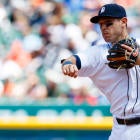On Nov. 20, 2013, the Tigers sent first baseman Prince Fielder to the Rangers in exchange for second baseman Ian Kinsler. At the time, Kinsler was headed into the second year of a five-year, $75 million contract that includes an option for 2018. Fielder, meantime, was going into the third year of a nine-year, $214 million pact that runs through 2020. Because of the difference in salary commitments, the Tigers also included $30 million cash in the deal.
So the Tigers, then, got Kinsler through 2017 at a cost of $62 million or $67 million if they choose the 2018 option over the buyout. Throw in the cash they sent to Texas and those figures become $92 million or $97 million for four or five seasons of Kinsler, respectively. As for the Rangers, Fielder from 2014-20 will make $168 million, which comes to $138 million after the Tigers' kick-in. We're roughly two-and-a-half seasons in, and here's how this major swap has shaken out thus far ...
| Player | Games played since trade | AVG/OBP/SLG since trade | WAR since trade |
| Kinsler | 385 | .288/.329/.438 | 14.9 |
| Fielder | 269 | .271/.349/.411 | 0.4 |
As you can see, this is a blowout. Kinsler has been vastly more durable, and he's put up comparable rate-based offensive numbers while providing plus fielding at an up-the-middle position and adding value on the bases. Fielder, meantime, has been a DH/defensive liability at first base while grading out as a steep negative on the bases.
Now let's throw dollars into the mix. Here's how much each team has paid for the production you see above, as measured by WAR (for 2016, we'll use half each player's total salary) ...
| Player | Dollars per WAR since trade |
| Kinsler | $2.6 million/WAR |
| Fielder | $150 million/WAR |
Well then. The Tigers have enjoyed a price that's roughly 30 percent of the going market rates for free agents, while the Rangers on a prorated basis have ... well, the numbers say it all. No, the figures above don't include Detroit's cash contributions, but those are just now being phased in (they'll send Texas $6 million per year starting this season through 2020). Even if you adjust the salary numbers by $30 million on each side, the Tigers are still ahead by an embarrassing margin. (Sure, WAR is hardly a perfect measure, but it's pegging these two about right, I'd say.)
In terms of value on the dollar, this has been one of the most lopsided trades in recent history, and all signs suggest it's going to get even better from the Detroit standpoint in the seasons to come. The Rangers are one of the best organizations in baseball, but they missed badly on this one.
As much of landslide as its been thus far, it could get even worse. Kinsler in his age-34 season remains highly productive (131 OPS+ entering Friday), while Fielder has been terrible (.205/.274/.315 on the year). At this point, it's quite defensible to suggest that the contending Rangers should cut bait on Fielder and eat the remaining years on his contract. That would be a huge sunk cost, but can they afford to have him on the roster as a spot player/pinch hitter? In the era of bloated bullpens, teams typically don't have the luxury of carrying a reserve who can play half a position. The Tigers, meanwhile, may wind up exercising Kinsler's $10 million option for his age-36 season. You don't expect someone who's logged more 12,000 innings at a high-attrition position like second base to age this well, but Kinsler has thus far staved off any hint of decline.






















